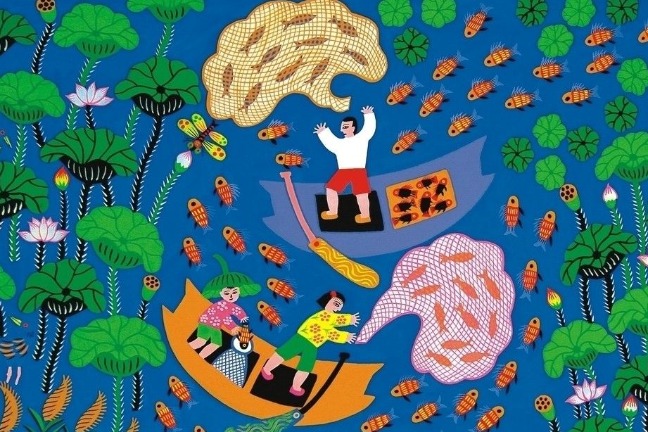Farmers paint a brighter future for themselves

Seated in his courtyard, Zhang Zilong uses a traditional Chinese fan as his canvas, and with meticulous strokes he paints a vivid rural landscape depicting distant hills and vibrant apricot blossoms.
Zhang, from Houhuangma village in Qingzhou, Shandong province, has battled physical disabilities since childhood. He initially earned a living through ceramic and glass painting. When the Qingzhou government arranged art training sessions for farmers, Zhang eagerly enrolled in the hope of further nurturing his artistic talent.
Farmer painting is an art form rooted in agricultural life. To seek inspiration, Zhang frequently ventures outdoors to capture scenes of rural landscapes, harvest festivals and local customs with the strokes of his paintbrush. He then reinterprets these scenes in his unique style. As his skills improved, Zhang began selling his paintings and eventually established his own studio.
Farmers using paintbrushes as a creative tool is a growing trend in many rural areas in Shandong. These farmer-artists celebrate rural beauty through their art, and this, in turn, helps them increase their incomes.
Ma Xiuhua, founder of a rural farmer painting cooperative in Qingzhou's Mihe township, says paintings by the farmers mostly serve as decorative art, often seen in rural resorts and kindergartens. Thanks to online platforms, customers across China can easily access these artworks.
"Successful farmer-artists can earn over 2,000 yuan ($277) monthly and if their works are selected for exhibitions, they can receive additional rewards," Ma says.
Yang Lisheng, an official with the cultural affairs office in Qingzhou, says derivative cultural products inspired by these paintings have been developed. The paintings created by local farmers have been printed on products such as ceramic plates, teapots, backpacks, silk scarves and T-shirts.
"A painting can be sold only once, but its derivative cultural products have enduring value," Yang says. "Selling these cultural products can bring in more income than the paintings themselves."
The style of farmer paintings varies across different regions. In the rural areas of Juye county, located in Shandong's Heze city, intricate peony wall paintings are a common sight.
Cheng Junwei, the director of Juye County Calligraphy and Painting Institute, says that through farmer painting training, villagers have acquired a profitable skill, allowing them to earn extra income during the agricultural offseason.
At present, there are eight townships and 50 villages in Juye county that specialize in farmer paintings. With about 160 training institutions established across the county, over 20,000 individuals are engaged in calligraphy and painting. Their artworks are now exported to over 40 countries and regions.
Related articles
-
 Colors, texts and poems, the gateways to an artist's world
Colors, texts and poems, the gateways to an artist's worldMore
-
 Interview of Designer of GPA Trophy
Interview of Designer of GPA TrophyMore
-
 A Chinese painter dedicated to cross-cultural communication through art
A Chinese painter dedicated to cross-cultural communication through artMore
-
 Ink paintings on show in Beijing to hail a new era
Ink paintings on show in Beijing to hail a new eraMore
-
 Fou Gallery presents "Interest in Humanity: Portraits of Yesterday and Today" in New York
Fou Gallery presents "Interest in Humanity: Portraits of Yesterday and Today" in New YorkMore
-
 In Rainbows: Solo Exhibition of QU Qianmei is on display in Shanghai
In Rainbows: Solo Exhibition of QU Qianmei is on display in ShanghaiMore
